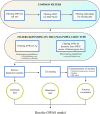Recommendations for Choosing the Genotyping Method and Best Practices for Quality Control in Crop Genome-Wide Association Studies
- PMID: 32587600
- PMCID: PMC7299185
- DOI: 10.3389/fgene.2020.00447
Recommendations for Choosing the Genotyping Method and Best Practices for Quality Control in Crop Genome-Wide Association Studies
Abstract
High-throughput genotyping boosts genome-wide association studies (GWAS) in crop species, leading to the identification of single-nucleotide polymorphisms (SNPs) associated with economically important traits. Choosing a cost-effective genotyping method for crop GWAS requires careful examination of several aspects, namely, the purpose and the scale of the study, crop-specific genomic features, and technical and economic matters associated with each genotyping option. Once genotypic data have been obtained, quality control (QC) procedures must be applied to avoid bias and false signals in genotype-phenotype association tests. QC for human GWAS has been extensively reviewed; however, QC for crop GWAS may require different actions, depending on the GWAS population type. Here, we review most popular genotyping methods based on next-generation sequencing (NGS) and array hybridization, and report observations that should guide the investigator in the choice of the genotyping method for crop GWAS. We provide recommendations to perform QC in crop species, and deliver an overview of bioinformatics tools that can be used to accomplish all needed tasks. Overall, this work aims to provide guidelines to harmonize those procedures leading to SNP datasets ready for crop GWAS.
Keywords: GWAS; bioinformatics tools; crops; genotyping; quality control.
Copyright © 2020 Pavan, Delvento, Ricciardi, Lotti, Ciani and D’Agostino.
Figures


Similar articles
-
Crop Breeding Chips and Genotyping Platforms: Progress, Challenges, and Perspectives.Mol Plant. 2017 Aug 7;10(8):1047-1064. doi: 10.1016/j.molp.2017.06.008. Epub 2017 Jun 29. Mol Plant. 2017. PMID: 28669791 Review.
-
Perspectives and recent progress of genome-wide association studies (GWAS) in fruits.Mol Biol Rep. 2022 Jun;49(6):5341-5352. doi: 10.1007/s11033-021-07055-9. Epub 2022 Jan 22. Mol Biol Rep. 2022. PMID: 35064403 Review.
-
Use of genotyping-by-sequencing to determine the genetic structure in the medicinal plant chamomile, and to identify flowering time and alpha-bisabolol associated SNP-loci by genome-wide association mapping.BMC Genomics. 2017 Aug 10;18(1):599. doi: 10.1186/s12864-017-3991-0. BMC Genomics. 2017. PMID: 28797221 Free PMC article.
-
Revolution in Genotyping Platforms for Crop Improvement.Adv Biochem Eng Biotechnol. 2018;164:37-52. doi: 10.1007/10_2017_47. Adv Biochem Eng Biotechnol. 2018. PMID: 29356847
-
Genotyping Platforms for Genome-Wide Association Studies: Options and Practical Considerations.Methods Mol Biol. 2022;2481:29-42. doi: 10.1007/978-1-0716-2237-7_3. Methods Mol Biol. 2022. PMID: 35641757
Cited by
-
Beyond bloom: validated marker-trait discovery for polyploid roses via GWAS.Front Plant Sci. 2025 May 13;16:1591861. doi: 10.3389/fpls.2025.1591861. eCollection 2025. Front Plant Sci. 2025. PMID: 40433153 Free PMC article.
-
Polygenic risk scores for eGFR are associated with age at kidney failure.J Nephrol. 2025 Apr;38(3):969-978. doi: 10.1007/s40620-025-02207-7. Epub 2025 Mar 3. J Nephrol. 2025. PMID: 40029548 Free PMC article.
-
Mapping yield and yield-related traits using diverse common bean germplasm.Front Genet. 2024 Jan 3;14:1246904. doi: 10.3389/fgene.2023.1246904. eCollection 2023. Front Genet. 2024. PMID: 38234999 Free PMC article.
-
Genetic approaches to exploit landraces for improvement of Triticum turgidum ssp. durum in the age of climate change.Front Plant Sci. 2023 Jan 27;14:1101271. doi: 10.3389/fpls.2023.1101271. eCollection 2023. Front Plant Sci. 2023. PMID: 36778704 Free PMC article. Review.
-
Merging genotyping-by-sequencing data from two ex situ collections provides insights on the pea evolutionary history.Hortic Res. 2022 Jan 19;9:uhab062. doi: 10.1093/hr/uhab062. Online ahead of print. Hortic Res. 2022. PMID: 35043171 Free PMC article.
References
-
- Allen A. M., Winfield M. O., Burridge A. J., Downie R. C., Benbow H. R., Barker G. L. A., et al. (2017). Characterization of a wheat breeders’ array suitable for high-throughput SNP genotyping of global accessions of hexaploid bread wheat (Triticum aestivum). Plant Biotechnol. J. 15 390–401. 10.1111/pbi.12635 - DOI - PMC - PubMed
-
- Astle W., Balding D. J. (2009). Population structure and cryptic relatedness in genetic association studies. Stat. Sci. 24 451–471. 10.1214/09-STS307 - DOI
Publication types
LinkOut - more resources
Full Text Sources
Molecular Biology Databases

